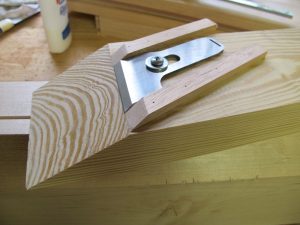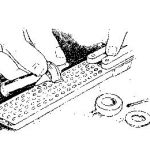We may receive a commission when you use our affiliate links. However, this does not impact our recommendations.
Some woodworkers would rather stick their hand into a running disposal while naked than turn on a dry grinder.
So when they need to correct the skew angle on a skewed plane iron or skewed chisel they are at a loss. I even met a guy who would just buy a new blade rather than learn to sharpen the skew angle.
If you are grinder-phobic, this blog post is for you. At the bottom of the post I’ll tell you how I do the operation on a dry grinder.
When you sharpen a skew blade, you are holding the tool at a compound angle – the bevel of the blade plus the skew angle. This trickiness causes some woodworkers to sharpen one corner of the tool more than the other, which changes the skew angle. Which makes the plane stop working.
Now let’s just say that I’m fairly stupid when it comes to geometry. And I am sure there is a simpler way to fix the skew – but I try to do things in a straightforward and safe manner. Here’s the gist of my skew correcting jig.
First measure the proper skew angle off the tool’s mouth or find it in the tool’s instructions (the white paper thing you threw away). For this Veritas Skew Rabbet Plane, the skew angle is 22°. Write that down. Then measure the angle of the primary bevel on the tool. Many joinery planes use a 30° bevel, as did this skew rabbet. Write this number down.
Now take a piece of 2x material or 8/4-thick stock. You are going to cut the bevel angle on the end of the wood, like you were making a giant chisel. Mark the bevel out on the edge of the board. Cut it with a band saw or handsaw. Plane up to the line.
Now set your bevel gauge to the skew angle (22° in my case). Use it to knife in a line that is 22° off the edge of your board. Glue and nail a thin batten on that line. Then put your plane blade against the batten and glue and nail a second batten pressed hard against the opposite edge of the tool.
This creates a 22° channel on the top of your jig. The only thing left to do is find a way to hold the tool in the channel. I used a pan-head screw and a washer to hold it in place.
Now you can secure your tool in the jig so its edge is a teeny bit proud of the big bevel, clamp the jig in a vise and use a diamond stone or sandpaper to true up the tool’s edge. Just rub the stone (or whatever) against that big bevel on your jig and it will grind an edge that is the proper skew and bevel angle.
You can even use this jig to hone and polish your edge. After grinding it, loosen the screw and scooch the blade forward about 1/16” or a little less. Then you rub the jig with your sharpening stones and they will dress only the bevel.
The jig works fine. Yes, the main bevel of the jig will wear a little bit, but by the time it becomes useless, you should be a better sharpener, right?
— Christopher Schwarz
P.S. Here’s how I do it on the dry grinder. I set the the tool’s skew angle on my sliding bevel and mark this angle on the unbeveled face of the tool using a fine marker. I set the tool rest on my grinder so it is parallel to the floor. I show the tool to the wheel and remove the metal down to the line. This corrects the skew and grinds a flat on the end of the tool.
Then I reset the grinder’s tool rest to 30° and grind away the flat until it disappears at the same time all across the edge. This corrects the skew. Then I just have to hone a new edge with my sharpening stones.
Here are some supplies and tools we find essential in our everyday work around the shop. We may receive a commission from sales referred by our links; however, we have carefully selected these products for their usefulness and quality.












I trued up two skew chisels (that I tried to hone free-hand) with Veritas’ shew honing jig and my Work-Sharp. Worked like a champ, with no geometry involved.
Just curious…how does being naked exacerbate the effects of sticking your hand in a garbage disposal?
I cheated and purchased Blum’s sharpening jig, the large one with the flexible blade angle positioned, which in effect, does the same thing. It also allows you to skew the blade, which allows me to sharpen most of my ‘weird’ non-contour type blades.